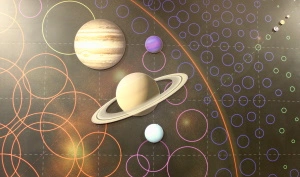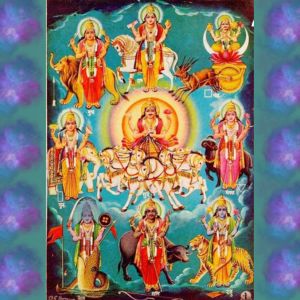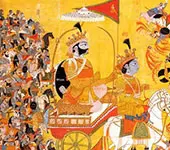This audio tells you about- 1. How Mahabharata got its name. 2. How Vyasa composed Mahabharata. 3. Meaning of the term Itihasa. 4. Purpose of Itihasas and Puranas.
Itihas in English meaning
рдЗрддрд┐рд╣рд╛рд╕рдГ тАУ рдЗрддрд┐рд╣ рдЖрд╕реНрддреЗ рдЕрд╕реНрдорд┐рдиреН. Itiha means traditional knowledge and advice for a virtuous living. That which contains itiha is Itihasa. Mahabharata and Ramayana, both contain itiha or paramparya upadesha about dharma.
Where Mahabharata war happened
Mahabharata war happened on the battlefield of Kurukshetra which is in the present-day Haryana state of India.
How many days did Mahabharata war last?
Mahabharata war lasted for eighteen days.
Quiz
In which Chhandas (meter) is Mahabharata written ?Transcript
(Click here to read more)
Mahabharata is called Itihasa. The other Itihasa is Ramayana. рдЗрддрд┐рд╣рд╛рд╕рдкреБрд░рд╛рдгрд╛рднреНрдпрд╛рдВ рд╡реЗрджрдВ рд╕рдореБрдкрдмреГрдВрд╣рдпреЗрддреН The principles of Vedas are very difficult to understand. They should be expounded and understood with the help of Itihasas and Puranas. рдирд┐рд░реНрдгрдпрдГ рд╕рд░реНрд╡рд╢рд╛рд╕реНрддреНрд░рд╛рдгрд╛рдВ рднрд╛рд░рддрдВ рдкрд░рд┐рдХреАрд░реНрддрд┐рддрдореН The final answer to shastras is Bharata. Shastra mentioned in Bharata ....
Transcript
(Click here)
Mahabharata is called Itihasa.
The other Itihasa is Ramayana.
рдЗрддрд┐рд╣рд╛рд╕рдкреБрд░рд╛рдгрд╛рднреНрдпрд╛рдВ рд╡реЗрджрдВ рд╕рдореБрдкрдмреГрдВрд╣рдпреЗрддреН
The principles of Vedas are very difficult to understand.
They should be expounded and understood with the help of Itihasas and Puranas.
рдирд┐рд░реНрдгрдпрдГ рд╕рд░реНрд╡рд╢рд╛рд╕реНрддреНрд░рд╛рдгрд╛рдВ рднрд╛рд░рддрдВ рдкрд░рд┐рдХреАрд░реНрддрд┐рддрдореН
The final answer to shastras is Bharata.
Shastra mentioned in Bharata is final.
Principles of dharma mentioned in Bharata are final.
And the author of Bharata is none other than Sri Hari himself.
рдпрдерд╛ рд╕ рднрдЧрд╡рд╛рдиреН рд╡реНрдпрд╛рд╕рдГ рд╕рд╛рдХреНрд╖рд╛рдиреНрдирд╛рд░рд╛рдпрдгрдГ рдкреНрд░рднреБрдГ
Vishnu Purana says тАУ
рдХреГрд╖реНрдгрджреНрд╡реИрдкрд╛рдпрдирдВ рд╡реНрдпрд╛рд╕рдВ рд╡рд┐рджреНрдзрд┐ рдирд╛рд░рд╛рдпрдгрдВ рдкреНрд░рднреБрдореН
рдХреЛрд╣реНрдпрдиреНрдпреЛ рднреБрд╡рд┐ рдореИрддреНрд░реЗрдп рдорд╣рд╛рднрд╛рд░рддрдХреГрджреНрднрд╡реЗрддреН
Know Vyasa to be Narayana himself.
Who else can create something as astounding as Mahabharata?
Once, Vyasa Maharshi told Devas to weigh shastras.
They put Mahabharata on one side of the balance and all the other shastras, scriptures on the other side.
Mahabharata stood heavier.
рднрд╛рд░рддрдВ рд╕рд░реНрд╡рд╡реЗрджрд╛рд╢реНрдЪ рддреБрд▓рд╛рдорд╛рд░реЛрдкрд┐рддрд╛рдГ рдкреБрд░рд╛ ред
рджреЗрд╡реИрд░реНрдмреНрд░рд╣реНрдорд╛рджрд┐рднрд┐рдГ рд╕рд░реНрд╡реИрд░реГрд╖рд┐рднрд┐рд╢реНрдЪ рд╕рдордиреНрд╡рд┐рддреИрдГ ред
рд╡реНрдпрд╛рд╕рд╕реНрдпреИрд╡рд╛рд╜рдЬреНрдЮрдпрд╛ рддрддреНрд░ рддреНрд╡рддреНрдпрд░рд┐рдЪреНрдпрдд рднрд╛рд░рддрдореН
It is because Mahabharata stood heavier than all other scriptures, because of its weight it is called Bharata.
And because of its greatness Mahabharata.
рдорд╣рддреНрд╡рд╛рджреНрднрд╛рд░рд╡рддреНрд╡рд╛рдЪреНрдЪ рдорд╣рд╛рднрд╛рд░рддрдореБрдЪреНрдпрддреЗ
The importance of Bharata is that the principles of dharma and adharma, righteousness and unrighteousness are not only declared as in Smritis and Dharma-sutras, they are also established with real-life examples in Mahabharata.
рдирд┐рд░реНрдгрдпрдГ рд╕рд░реНрд╡рд╢рд╛рд╕реНрддреНрд░рд╛рдгрд╛рдВ рд╕рджреГрд╖реНрдЯрд╛рдиреНрддреЛ рд╣рд┐ рднрд╛рд░рддреЗ
рдорддрд┐рдВ рдордиреНрдерд╛рдирдорд╛рд╡рд┐рдзреНрдп рдпреЗрдирд╛рд╕реМ рд╢реНрд░реБрддрд┐рд╕рд╛рдЧрд░рд╛рддреН
рдкреНрд░рдХрд╛рд╢рдВ рдЬрдирд┐рддреЛ рд▓реЛрдХреЗ рдорд╣рд╛рднрд╛рд░рддрдЪрдиреНрджреНрд░рдорд╛рдГ
While the Devas and Asuras were churning the milky ocean, the moon came out of it.
Likewise, when the Shrutisagara the ocean of Vedas, the ocean of knowledge was churned by Vyasa what came out was Mahabharata like a moon spreading its light all over the world.
рдпреЛ рд╡рд┐рджреНрдпрд╛рдЪреНрдЪрддреБрд░реЛ рд╡реЗрджрд╛рдиреН рд╕рд╛рдВрдЧреЛрдкрдирд┐рд╖рджрд╛рдиреН рджреНрд╡рд┐рдЬрдГ
рди рдЪрд╛рдЦреНрдпрд╛рдирдорд┐рджрдВ рд╡рд┐рджреНрдпрд╛рдиреНрдиреИрд╡ рд╕рд╕реНрдпрд╛рджреНрд╡рд┐рдЪрдХреНрд╖рдгрдГ
The scholar who knows all the four Vedas along with their six angas such as Shiksha, Niruktam, and Upanishads he can not be called an acclaimed scholar if he doesnтАЩt know Mahabharata.
рдпрджрд┐рд╣рд╛рд╕реНрддрд┐ рддрджрдиреНрдпрддреНрд░
рдпрдиреНрдиреЗрд╣рд╛рд╕реНрддрд┐ рди рддрддреНрдХреНрд╡рдЪрд┐рддреН
Whatever is there in Mahabharata that alone you can find them elsewhere also, but if there is something that is not there in Mahabharata, you will never be able to find it elsewhere.
And how did sage Vyasa get to know about all this?
Bharata is huge, the incidents narrated here, the principles elaborated here are enormous in terms of size itself.
What were Vyasa's resources?
We know Vyasa is Maha Vishnu himself.
рднрд╛рд░рддрд╕реНрдпреЗрддрд┐рд╣рд╛рд╕рд╕реНрдп рдзрд░реНрдореЖрдгрд╛рдиреНрд╡реАрдХреНрд╖реНрдп рддрд╛рдВ рдЧрддрд┐рдореН
рдкреНрд░рд╡рд┐рд╢реНрдп рдпреЛрдЧрдВ рдЬреНрдЮрд╛рдиреЗрди рд╕реЛрд╜рдкрд╢реНрдпрддреН рд╕рд░реНрд╡рдордиреНрддрддрдГ
Sitting in a cave at the base of the Himalayas in yoga bhava, he saw all these inside him.
He didnтАЩt read it from somewhere, or hear it from someone.
Like a movie, he saw everything within himself, playing out scene by scene, with the power of yoga.
Everything is explained here, whatever incidents have happened in the past, what we today call History, thery are all explained in Bharata.
There are two kinds of explanations- concise and elaborate.
Whatever should be explained concisely, only essentials, they are explained that way.
And wherever details are required, they are explained that way.
рддрдкрд╕рд╛ рдмреНрд░рд╣реНрдордЪрд░реНрдпреЗрдг рд╡реНрдпрд╕реНрдп рд╡реЗрджрдВ рд╕рдирд╛рддрдирдореН
рдЗрддрд┐рд╣рд╛рд╕рдорд┐рдордВ рдЪрдХреНрд░реЗ рдкреБрдгреНрдпрдВ рд╕рддреНрдпрд╡рддреАрд╕реБрддрдГ
Mahabharata is an expansion of Vedas and Sage Vyasa accomplished this task through his tapas and brahmacharya.
Brahmacharya is not always celibacy.
It has other meanings also, brahma is mantra, brahmacharya also means the path of mantras, depending on the power of mantras.
What is the meaning of the term Itihasa?
рдЗрддрд┐рд╣рд╛рд╕рдГ тАУ рдЗрддрд┐рд╣ рдЖрд╕реНрддреЗ рдЕрд╕реНрдорд┐рдиреН
Itiha means Paaramparyopadesha, advices are there in this; how to live a fruitful, worthwhile, complete, righteous life.
Learning what is right and wrong through examples.
Looking at how others lived, clarity comes, how to live, hence it is called Itihasa.
Both Bharata and Ramayana, it is from these that you learn how to live.
рдзрд░реНрдорд░реНрдердХрд╛рдордореЛрдХреНрд╖рд╛рдгрд╛рдВ рдЙрдкрджреЗрд╢рд╕рдордиреНрд╡рд┐рддрдореН
рдкреВрд░реНрд╡рд╡реГрддреНрддрдХрдерд╛рдпреБрдХреНрддрдВ рдкреНрд░рдЪрдХреНрд╖рддреЗ
Advice with respect to all four Purusharthas- Dharma, Artha, Kama, and Moksha.
And incidents of the past, it is not fiction.
They are all real incidents.
Katha does not necessarily mean story, imagination as in English.
In Sanskrit, Katha also means vartha, vakyam.
The word Katha conveys a wrong impression.
That it is a myth or somebodyтАЩs imagination.
In Sanskrit, it is not so.
Here, they denote news from the past, incidents from the past, that is why Itihasa is often equated with History.
Recommended for you
Mantra From Atharva Veda For Happiness And Comfort

рдпрд╛рдирд┐ рдирдХреНрд╖рддреНрд░рд╛рдгрд┐ рджрд┐рд╡реНрдпрдиреНрддрд░рд┐рдХреНрд╖реЗ рдЕрдкреНрд╕реБ рднреВрдореМ рдпрд╛рдирд┐ рдирдЧреЗрд╖реБ рджрд....
Click here to know more..Adhi Yoga In Astrology

Learn about the prminent Astrological combination called Adhi Yoga and its results.....
Click here to know more..Eka Sloki Navagraha Stotram

рдЖрдзрд╛рд░реЗ рдкреНрд░рдердореЗ рд╕рд╣рд╕реНрд░рдХрд┐рд░рдгрдВ рддрд╛рд░рд╛рдзрд╡рдВ рд╕реНрд╡рд╛рд╢реНрд░рдпреЗ Aadhaare prathame sahasrakiranam t....
Click here to know more..
English Topics
Mahabharatam
Click on any topic to open
- 95 What is behind Calling the Five Brothers the Pandavas
- 94 Give up an Individual IF....
- 93 Fascinating Birth Story of the Kauravas
- 92 Overcoming Grief - Lessons from King Senajit's story
- 91 Yayati's Wisdom
- 90 Yayati's Story
- 89 Brahmacharis Can Bless And Curse
- 88 Human Nature - Comples Mix Of Good And Bad
- 87 Results Of Good Karma
- 86 What Gives Results - Luck or Effort?
Please wait while the audio list loads..
7
5
30
Ganapathy
Shiva
Hanuman
Devi
Vishnu Sahasranama
Mahabharatam
Practical Wisdom
Yoga Vasishta
Vedas
Rituals
Rare Topics
Devi Mahatmyam
Glory of Venkatesha
Shani Mahatmya
Story of Sri Yantra
Rudram Explained
Atharva Sheersha
Sri Suktam
Kathopanishad
Ramayana
Mystique
Mantra Shastra
Bharat Matha
Bhagavatam
Astrology
Temples
Spiritual books
Purana Stories
Festivals
Sages and Saints
26
рдЬрдп рд╢реНрд░реАрд░рд╛рдо
рджреЗрд╡реА рднрд╛рдЧрд╡рдд
рд╡рд┐рднрд┐рдиреНрди рд╡рд┐рд╖рдп
рдЧрдгреЗрд╢ рдЕрдерд░реНрд╡ рд╢реАрд░реНрд╖
рдЬрдп рд╣рд┐рдВрдж
рдордВрджрд┐рд░
рд╢рдирд┐ рдорд╛рд╣рд╛рддреНрдореНрдп
рд╢реНрд░реАрдпрдВрддреНрд░ рдХреА рдХрд╣рд╛рдиреА
рднрдЬрди рдПрд╡рдВ рдЖрд░рддреА
рдЧреМ рдорд╛рддрд╛ рдХреА рдорд╣рд┐рдорд╛
рдпреЛрдЧ
рд╕рджрд╛рдЪрд╛рд░
рднрдЧрд╡рджреНрдЧреАрддрд╛
рдорд╣рд╛рднрд╛рд░рдд
рд╢рд┐рд╡ рдкреБрд░рд╛рдг
рднрд╛рдЧрд╡рдд
рдЬреНрдпреЛрддрд┐рд╖
рдЖрдзреНрдпрд╛рддреНрдорд┐рдХ рдЧреНрд░рдиреНрде
рд╢реНрд░реАрдХреГрд╖реНрдг
рд╡реНрд░рдд рдПрд╡рдВ рддреНрдпреЛрд╣рд╛рд░
рд╢реНрд░рд╛рджреНрдз рдФрд░ рдкрд░рд▓реЛрдХ
рдкреБрд░рд╛рдг рдХрдерд╛
рдмрдЪреНрдЪреЛрдВ рдХреЗ рд▓рд┐рдП
рдХрдареЛрдкрдирд┐рд╖рдж
рд╕рдВрдд рд╡рд╛рдгреА
рд╕реБрднрд╛рд╖рд┐рдд
15
роХрогрокродро┐
родро┐ро░рпБро╡ро┐ро│рпИропро╛роЯро▓рпН
роЪрпБро╡ро╛рооро┐ роРропрокрпНрокройрпН
роЪро┐ро╡рокрпБро░ро╛рогроорпН
роХрогрпНрогройрпН
родрпЗро╡ро┐
ро╡рпЗро▒рпБ родро▓рпИрокрпНрокрпБроХро│рпН
рокроЮрпНроЪ родроирпНродро┐ро░роорпН
роЗро░ро╛рооро╛ропрогроорпН
роХрпЛро╡ро┐ро▓рпНроХро│рпН
роЬрпЛродро┐роЯроорпН
роЖройрпНроорпАроХ рокрпБродрпНродроХроЩрпНроХро│рпН
роЪро┐ро▒рпБро╡ро░рпНроХро│рпБроХрпНроХро╛роХ
рокро╛роХро╡родроорпН
родро┐ро░рпБроХрпНроХрпБро▒ро│рпН
13
р┤Чр┤гр┤кр┤др┤┐
р┤Хр╡Нр┤╖р╡Зр┤др╡Нр┤░р┤Щр╡Нр┤Щр┤│р╡НтАН
р┤жр╡Зр┤╡р╡Ар┤нр┤╛р┤Чр┤╡р┤др┤В
р┤нр┤╛р┤Чр┤╡р┤др┤В
р┤╣р┤░р┤┐р┤ир┤╛р┤о р┤Хр╡Ар┤░р╡НтАНр┤др╡Нр┤др┤ир┤В
р┤кр┤▓ р┤╡р┤┐р┤╖р┤пр┤Щр╡Нр┤Щр┤│р╡НтАН
р┤╢р┤ир┤┐ р┤ор┤╛р┤╣р┤╛р┤др╡Нр┤ор╡Нр┤пр┤В
р┤ор┤╣р┤╛р┤нр┤╛р┤░р┤др┤В
р┤Ьр╡Нр┤пр╡Лр┤др┤┐р┤╖р┤В
р┤Жр┤др╡Нр┤ор╡Ар┤п р┤Чр╡Нр┤░р┤ир╡Нр┤ер┤Щр╡Нр┤Щр┤│р╡НтАН
р┤кр╡Бр┤░р┤╛р┤г р┤Хр┤ер┤Хр┤│р╡НтАН
р┤Хр╡Бр┤Яр╡Нр┤Яр┤┐р┤Хр┤│р╡НтАНр┤Хр╡Нр┤Хр┤╛р┤пр┤┐
р┤ор┤╣р┤др╡Н р┤╡р┤Ър┤ир┤Щр╡Нр┤Щр┤│р╡НтАН
